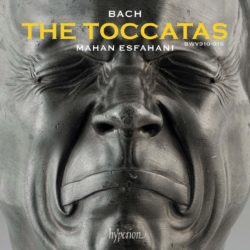Classical Music CD Review: “Bach: Toccatas” — A Harpsichord of Feral Energy
By Susan Miron
Bach: Toccatas, Mahan Esfahani. Hyperion Records
In this extraordinary recording, harpsichordist Mahan Esfahani is given a chance to perfectly convey the power of his emotions.

“The harpsichord has no limits on its expression” proclaims the brilliant, occasionally controversial harpsichordist Mahan Estafani. “If you’re okay with that, then you’re okay with the (this) album…. When people hear the word ‘harpsichord,’ a guard goes up. You have to push it from the musicianship and engagement side, of course. But you also have to push it from the ‘Come on, people, give up these preconceptions’ side, too. The harpsichord is like the posh, pretty boy in the prison. He’s gonna get beaten on.”
Esfahani opens his new CD of Bach’s Toccatas with almost feral energy. This is Bach with attitude, exuberance, and ecstasy. It is as if he had waiting his whole life to play these fantastically difficult pieces, which Bach wrote in his twenties. In fact, Esfahani admits in an interview with The Guardian that he has been living with this for half his life. He describes the Toccatas, performed surprisingly infrequently, as “intense, deep, but with a lot of humor. It’s Young Bach still experimenting, in his twenties, a bit of a show off.” Bach, Esfahani feels, “is special because he’s better than what we can do with his music. The closer you get to figuring it out a thousand other doors open and your realize you’re back where you started. It’s a very humbling experience. He’ll always be above us. And yet he’s very human.”
Born in Tehran in 1984, Esfahani was raised in the United States. He lived in Milan and then London for several years. He now resides in Prague. At Stanford University, he found his first devoted harpsichord teacher. Asked how he felt about learning the harpsichord, he admits it was like falling in love. He had been playing the flute and violin, but it was as if he had a hand over his mouth: “The second I played a harpsichord, it was as if the hand had been removed. This was the sound I’d been looking for to express myself.” And, on this extraordinary recording, he is given a chance to perfectly convey the power of his emotions.
Bach’s set of seven Toccatas for keyboard date from 1708-10. To Bach, the toccata was a multi-movement suite, often very free in form. Each of his toccatas contains at least one slow movement and one fugue; some of the movements are fantasia-like in structure. Although Bach often omits tempo markings, the sections of individual movements appear to call for quite different tempos. It is up to the performer to determine the ‘correct’ speeds and their relation to the various parts.
In his rather scholarly liner notes, Esfahani writes, “The toccatas are amongst Bach’s most mysterious works due to the paradoxical scenario of a largely taciturn composer refusing to tell us exactly what we should do while simultaneously presenting scores so clearly in need of the (respectful) intervention — or rather, participation — of a performer.” To arrive at what he felt was at least arguably correct, Esfahani constructed his own edition. In addition, he is using a harpsichord he commissioned from a Finnish builder with a deep sub-base register, which allows him to play with electrifying ferociously.

Harpsichordist Mahan Esfahani. Photo: You Tube.
More from Esfahani’s liner notes:
The toccatas are amongst Bach’s most mysterious works due to the paradoxical scenario of a largely taciturn composer refusing to tell us exactly what we should do while simultaneously presenting scores so clearly in need of the (respectful) intervention or, rather, participation of a performer. They reward the keyboardist with the beautiful sparks emanating from the perpetual conflict between disorderly flamboyance and everlasting truth, a brief glimpse of something sacred showing itself to us through an old box with some strings stretched across it.
As with virtually all of J.S. Bach’s early works, the seven toccatas (BWV910 – 916) have a rather tormented source history. In fact, none survives in any autograph form. “Unlike the partitas or the English suites, Esfahani explains, “these works were most likely not intended by Bach as a single collection, and the seventh one, in G major (BWV916), was alternatively named in at least one source — now lost — as a ‘concerto,’ which indeed it is, having very little to do with what Bach (or we) think of as a ‘toccata’ save perhaps the fugue in the third movement. Fortunately, however, almost all of the toccatas have as their principal sources collections copied out by those close to J S Bach, and so in the fog of the variant readings, occasional textual mistakes, and wildly different approaches to ornamentation, one can get a basic idea of the essential aspects of a musical text as Bach intended it.”
Esfahani’s harpsichord playing here hardly sounds like that of a posh, pretty boy in a prison — unless that pretty boy had just spent a year bulking up in a gym, working out and lifting weights.
Susan Miron, a harpist, has been a book reviewer for over 30 years for a large variety of literary publications and newspapers. Her fields of expertise were East and Central European, Irish, and Israeli literature. Susan covers classical music for The Arts Fuse and The Boston Musical Intelligencer.
Tagged: Bach: Toccatas, Hyperion, Hyperion Records
